There are built-in hoods without ventilation. Installation and operation. The influence of kitchen hoods on ventilation
It is hard to imagine modern kitchen without an extractor hood that rids the room of odors, combustion products and fumes released during cooking. Especially relevant is the problem of installing a hood in, where all the rooms are combined into a common space, so there is no way to close the doors while cooking. Sometimes the ventilation shaft and the gas stove are located at a considerable distance from each other, the owners of a home with such a kitchen are interested in the question: “Is there a hood without pipes?”
There are two constructive solutions of the device: with air outlet and with air circulation. Circulation models - hoods with a filter without a vent, in hoods with a vent, combustion products and odors are removed into the ventilation system. There are also models that combine two modes of air purification, and experts believe that this best option for kitchen.
The principle of operation of the circulation hood
In a kitchen hood without an air duct, polluted air is taken in, cleaned when passing through the filters and thrown back, that is, it constantly circulates in a limited space. The device uses two types of filters: grease trapping, which trap fat and soot; and coal, absorbing odors.
Advantages of a hood in the kitchen without a drain
- the most significant advantage of the hood without connecting to ventilation is that it is quite possible to do without a ventilation shaft (hole in the wall) in the kitchen;
- the hood to the kitchen without a pipe is easy to install;
- the room retains heat, which is especially important in cold weather.
Cons of circulation hood
- the need to change carbon filters approximately every three months. Usually, the duration of use of the filters is indicated in the manufacturer's instructions, but individual companies supply their products with various indicators that suggest that it is time to replace the filters;
- low efficiency compared to a flow-through hood (maximum air purification does not exceed 70%).
Varieties of hoods without a drain
Flat hoods consist of a body panel, a fan and filters. Models made of glass, aluminum and chrome hoods look aesthetically pleasing and modern. Thanks to its compact dimensions, the device fits perfectly into the limited space of a small kitchen. Flat hoods can be horizontal and vertical.
A very convenient solution is a built-in extractor hood without a drain that fits into any interior, as it is hidden by a wall cabinet or panel.
It is difficult to imagine a modern kitchen without household appliances, and without a stove and a refrigerator - it is almost impossible. In the same way, there are no apartments left in nature, the kitchens of which are not equipped with hoods, or as they are also called exhaust hoods. It is these structurally simple products that remove air polluted with fatty inclusions, excessive moisture and combustion products, thereby allowing us to breathe fresh air.
But most of our apartments are equipped with one ventilation duct in the kitchen, and the second in the bathroom. By connecting an exhaust hood, most people are deprived of the only exhaust outlet in their own kitchen. In fairness, it should be said that when the hood is working, the polluted air is perfectly removed from the kitchen. But what happens when the hood is turned off?
The natural circulation of air in our home is disturbed, and this inevitably leads to stagnation of air masses in the room. It was in order to free the ventilation duct that the kitchen hood was invented without a vent to the ventilation.
The principle of operation of the exhaust hood without an air duct
Such kitchen umbrella, outwardly practically does not differ from standard hoods. Its only difference is that it does not need a ventilation system for operation and it does not remove air, as it works in recirculation mode.
 The principle of operation of the umbrella is extremely simple: the fan sucks in polluted air from the kitchen, which immediately enters the filtration system, where it is cleaned of unpleasant odors, fat deposits and excess moisture. After cleaning, the air is re-entered into the room. Air recirculation in the hood is the basic principle on which all its work is built. The quality of air purification depends on only two factors:
The principle of operation of the umbrella is extremely simple: the fan sucks in polluted air from the kitchen, which immediately enters the filtration system, where it is cleaned of unpleasant odors, fat deposits and excess moisture. After cleaning, the air is re-entered into the room. Air recirculation in the hood is the basic principle on which all its work is built. The quality of air purification depends on only two factors:
- Device power.
- filtering system.
Filter systems used in kitchen umbrellas
A modern kitchen hood without air outlet into the ventilation duct is a high-tech equipment that, despite its simple design, has several stages of air purification. In the most common and affordable models, there are two of them.
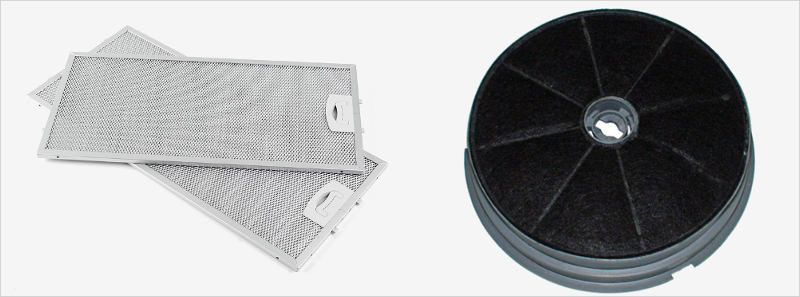
Types of kitchen umbrellas
Without exception, all kitchen hoods with a filter without a drain use the same principle of operation, but there are still differences between them, according to the way they are installed.
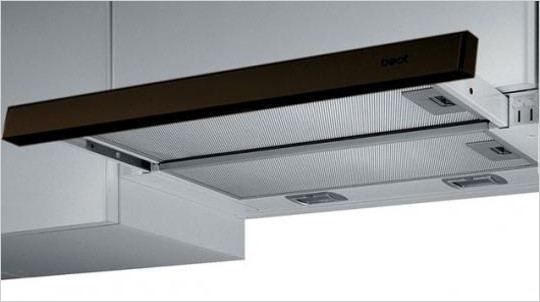
Hoods without a drain can have different functional solutions, depending on where they will be installed. There are standard wall-mounted hoods, there are island and corner models. All this is done to create maximum user convenience.
Advantages and disadvantages of exhaust hoods without an air duct
Like all kitchen appliances. Such equipment has undeniable advantages and rather serious disadvantages. The advantages of these hoods are:
- In ease of installation. To connect the hoods, air ducts and additional ventilation grilles are not needed. Any home master will install such a kitchen umbrella in his own kitchen in a matter of minutes.
- Hoods of this design use less electricity to operate, so they are more economical than ducted models.
- This household appliance is quite cheap. Those who are experiencing financial difficulties should consider these models for purchase.
And now a few words about the shortcomings, or rather, about one, but a serious drawback of umbrellas of this design.
The main and only disadvantage of kitchen umbrellas of this design worthy of consideration is regular replacement of filter elements. Depending on frequency of use carbon filter for the hood will have to be changed every 3-6 months.
Rules for choosing kitchen hoods
To choose the right exhaust equipment you need to know the performance required for your premises. Calculating it is quite simple: kitchen area should be multiplied by 12. The resulting figure will be an indicator of the device performance you need. In some cases, if the kitchen area is large, it is better to opt for devices connected to ventilation system. They are produced with a sufficient power reserve.
Some complain about the limited design choices of these devices. If the appearance of the appliance is the most important criterion for choosing a hood, then you should pay attention to the variety of hoods with duct connection.
Almost all models without duct connection are quite noisy. And if the noise indicator is critical for you, then you should give your preference to plug-in models of hoods.
Choose a device in which the grease filter for the hood will consist of 5 or more layers of aluminum mesh. Grease filters with fewer layers are ineffective.
Advice:
If your home has quality plastic windows, and there is only one ventilation duct in the kitchen, then it is worth buying a kitchen umbrella without connecting to the ventilation air duct. The duct of the ventilation system should be left open, as it will regulate the air exchange and the removal of exhaust air masses from your home when the umbrella is inoperative.
The range hood is an essential item in the kitchen. However, the standard option, when the device is connected to the duct and draws air into the ventilation shaft, may not always be used.
In such cases, you can use an alternative: now there are hoods with a recirculation mode that do not need to be connected to the ventilation duct.
The principle of operation and features of the device
A typical range hood is a fan that sucks in air and blows it into a duct. Air duct - connects to the ventilation shaft of the house (less often - directly to the street).
Hood without outlet not connected to air duct . In fact, it is not an exhaust device, but a filtration device, that is, an air purifier.The air in this case is not removed from the kitchen, but is recirculated in one room, therefore such devices are called recirculation.
Installed in the bodytwo-stagefiltration system (more on it below). Coming through 2 filters, purified air is not removed through the ventilation shaft, but blown out back to the kitchen.He enters the roomthrough holes that can be located on the sides, top, or front end corps.
Some models above the body have a box protruding upwards, on which holes are located. In this case, the outgoing air will enter the upper part of the room, where it will not interfere with anything (it will not blow anything off the table or shelves).
Otherwise, recirculation models have the same device as conventional hoods. They can have a backlight, speed control. Models may differ in placement:
Mounted. Such a device is mounted on the wall above the stove.
Embedded. In this case, the product is "hidden" in a cabinet that is hung above the stove.
Island. Attached not to the wall, but to the ceiling. Relevant if the plate is not located right next to the wall.
Corner. Can be mounted in the corner of the room.
How it works (video)
Pros and cons: is it worth choosing?
At Devices of this type have the following advantages:
- if the room has an opening in the ventilation shaft, it will not have to be occupied by an exhaust duct (as a result, air exchange will not be disturbed in the room);
the ability to use the hood where it is impossible to connect to the duct or make a tap to the street;
comparatively cheap: recirculatingmodels are cheaper than conventional hoods (with an air duct),and no need to spend money on additional parts (air duct and cabinets to hide it, brackets);
R The dimensions of such models are usually smaller than those of conventional hoods;
P ease of connection: there is no need to install an air duct, so it is easier and faster to install them,and take up less space(about installation - separately below);
for long-term operation of such a hood, no air supply is required, since it is not removed from the room (a conventional hood removes air, which means that there must be an inflow of air, which can be problematic in the cold season).
The last advantage is controversial, it can also be attributed to the disadvantages: the flow of air into the room (for a person to breathe) is still required even in winter. In addition, with constant recirculation of air (which contains moisture particles), the humidity in the room will increase.
As a result, if only to "drive" the airrecyclinghood, and do not allow to act fresh - The room will be stuffy. So over time, mold may appear.
In addition, such devices have other disadvantages:
frequent replacement of filters is required, which are expensive and cannot be cleaned(more on filters below);
a small selection of models: there are several times fewer recirculating hoods on the market than conventional ones;
stronger noise: in order to “push” air through the carbon filter, you need a more powerful (and therefore noisier) engine;
if the filters are of poor quality, not only smells, but also particles of fat can remain in the room (and since the air is blown out under pressure, fat can settle throughout the kitchen, on furniture, floors and walls);
not ideal efficiency: even a freshly installed filter will not completely clean the air of odors if they are very strong.
In what cases is it useful to use?
Which device is better use in cases where it is not possible to remove polluted air into the mine:
the opening of the ventilation shaft is located too far from the installation site of the hood;
disrupted work natural ventilation, because of which the air (and odors) removed by the hood can get to the neighbors (such a problem is not uncommon in old houses);
there is no ventilation shaft in the house at all (or there is no hole in the right room);
there is no space for laying an air duct;
a large hood or air duct does not fit into the design of the kitchen.
The conclusion can be drawn as follows: it is worth choosing recirculation hoods only in cases where there is no way to use conventional models(with air duct). Conventional exhaust mode is much more efficient and easier than recirculation mode.
Alternatively, if there is no way to install a conventional hood, you can install a model with recirculation, and to improve ventilation in the room, use:
supply valve or installation (so that there is a supply of fresh air);
in exhaust fan (in the wall, blowing directly onto the street, or into the ventilation shaft),moreover, it is recommended to put it as close as possible to the hood, turn it on simultaneously.
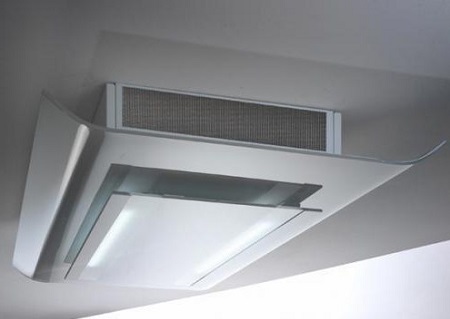
This solution is also suitable for those who have already installed a hood without a drain, but are disappointed in its effectiveness.
Description of filters and care rules
AT Recirculating hoods have two filters:
Grease trap. The standard filter for any hood is a metal mesh through which air passes first. Serves to stop large particles. Periodically requires cleaning.Less common (usually in the cheapest models) are anti-grease filters made of other materials.
carbon filter (absorption, anti-odor). Serves for finer purification of air from small particles and odors.It cannot be cleaned, only replaced with a new one.
The anti-grease filter is cleaned as it gets dirty. Periodically it is desirable to look at its condition, and if necessary - remove and wash.
Since the carbon filter cannot be seen, it is replaced:
After a certain period.
If the operation of the hood has deteriorated (it has become worse to “pull” air, it is worse to clean it, it makes more noise).
Some models (of the more expensive ones) have a sensor that indicates when the filter is dirty and needs to be replaced.
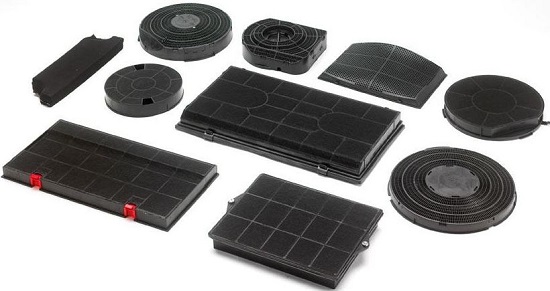
The timing of the replacement of the carbon filter is always individual, and depends on the following factors:
from the quality itselffilter element(cheap models will clog faster than better ones);
on what kind of food is cooked, and how often: if you cook borscht and fry meat every other day, then the filter will clog quickly.
On average, the service life of a set of carbon filters ranges from 2-3 weeks (with frequent cooking of "heavy" food) and up to 3-4 months (with less frequent use and cooking not too fatty and aromatic dishes).
By cost : 1 carbon filter can cost about 250 to 700 rubles (medium range). It is easy to calculate that if you change it once a month, and buy the most cheap option- then for the year it will cost an additional 3000 rubles.
2в1 - hoods with air duct and recirculation mode
There are 3 types of models on the market today:
Conventional hoods with an air duct that remove air from the kitchen.
Recirculating hoods that purify the air and feed it back into the kitchen.
Ducted models with recirculation mode. They can be used both as a conventional hood (which will remove air) and as a recirculation hood.

The third option appeared relatively recently, and the range of such devices is not very wide. Connecting an air duct is only necessary to remove air - that is, if you plan to use the hood only in recirculation mode, then it is not necessary to mount the outlet.
Models of this type are not particularly popular, and, in fact, are of little use for the following reasons:
they cost more than products with a single function;
the recirculation mode is less efficient than a conventional hood, so it is unlikely to be used in practice.
Mounting Features
As mentioned above, the installation of filter hoods is much easier and faster than products with an air duct.
To begin with, a place is selected for the location of the hood above the stove. Recommended height: for gas stoves: 75-85 cm; for electric stoves: 65-75 cm.
AT In the selected place, the case is hung on the wall (or on the ceiling - if the model is an island) on bolts.
Everything - no laying of air ducts, installation of grilles, installation of decorative cabinets - is not required.
List of models without outlet and models with two modes (hood / recirculation)
P Since the number of models is quite large - we will give only a few options, for example.
Models with recirculation only -are the least common, and not every manufacturer. Usually they are cheap, there are few expensive products in this category.
A few examples(at it seems the manufacturer, one of the models, and the price in rubles ) :
- Electrolux (EFP 6411 - about 4600 rubles).
- Cata (F 2050 - about 3500).
- Pyramida (WH 10-50 - about 2100).
- Kaiser (A 6413 - about 10300).
- Faber (Flexa HIP A 50 - about 5400).
- Elica (Concorde F / 50 - about 3000).
- Perfelli (DNS 6521 - about 16500).
- Falmec (Mimosa Parete 60,600 - about 20,000).
- Siemens (LI 28030 - about 17500).
- Hansa (OKC 5662 - about 7100).
Ardo (Basic F60 - about 3300).
A large selection of filtration models can be found at Cata, Electrolux, Pyramida, Kaiser, Falmec.
Models with 2 modes (removal and recirculation) are more common. Such products are produced by almost every manufacturer (some brands have more such models, others have less). You can distinguish them by the mode of operation, which indicates "removal / recirculation", or "hood / recirculation".
The principle of operation of the hood for the kitchen without an air duct, advantages and disadvantages, tips for choosing
Choosing a hood for a person who does not understand the intricacies of this simple device is quite difficult. Often, during a consultation, a specialist claims that it is not possible to mount an air duct in your kitchen. What to do in such a situation? Abandon the air cleaner and return to the traditional window? No. You just need to choose a model without an air duct. How to do it right? What are the good and bad of such cleaners for the kitchen?
The principle of operation of kitchen hoods
Air purifiers are classified according to how they work. The devices are divided into:
- flowing;
- recirculation;
- mixed type.
If the flow extractor is turned on in the kitchen, the polluted air is discharged through the duct into the central ventilation system. It is replaced by an influx of fresh air mass. For high-quality operation of hoods of this type, it is necessary that a window (window) be ajar in the adjacent room. Flow hoods are considered the most effective due to the complete replacement of the air volume. But they require mandatory installation of an air duct, which is not always possible.
Work recirculation hood based on the opposite principle. The purifier absorbs the flow of polluted air and, passing it through its own filtration system, returns it cleaned back to the room. In such electrical appliances, up to four coarse and fine filters are installed. The former purifies the air of large particles and drops of fat, the latter trap the smallest pollution and unpleasant odors.
The latter are capable of operating both in the mode of flow-through replacement of the air volume, and in the recirculation mode. What makes such models more preferable for the consumer. Although the price for them is higher than for mono-mode cleaners.
Advantages and disadvantages of kitchen hoods without an air duct
Often the opinions expressed about recirculating cleaners are not the most flattering. Many consider them frivolous and do not take into account the advantages of such devices.
Benefits of ductless hoods
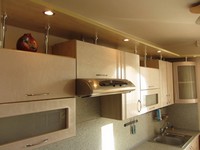
A non-flowing hood has many positive characteristics:
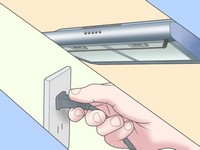
Disadvantages of hoods without an air duct
There are no ideal electrical appliances, along with positive aspects, there are always negative ones. Disadvantages of hoods for the kitchen without an air duct:
- Such models are quite simple and of the same type in design. For the most part, they are intended for small spaces and cannot please consumers with a variety of appearance.
- In addition, fine filters require regular replacement. Which is a source of constant additional expenses, especially when there are several carbon filters in the hood or the appliance is operating in enhanced mode. But it is worth noting that a system of replaceable filters is also installed in modern flow units.
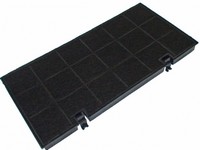
Many are interested in the question: how often do you need to replace? There can be no single answer. Much depends on the manufacturer in different models, a period of two months to six months, and sometimes up to 12 months, is indicated. Additionally, the service life is affected by the intensity of the device and the attentive attitude of the hostess. If the hood is not turned off immediately after cooking, but after a few minutes, then the filter elements will have to be replaced less often.
What determines the choice of hood for a kitchen without an air duct?
From the foregoing, we can conclude that a hood without an air duct is in many cases a great choice. This small household cleaner looks great in the clean design of small kitchen spaces and does a great job. But for this to happen, before buying, you need to consider a few points:
- You need to choose an air purifier, first of all, according to the level of its performance. To find out which indicator is suitable for a particular room, you need to multiply the area of \u200b\u200bthe kitchen by the height of the ceiling and multiply the result by 12. The resulting figure is an indicator of the required performance.
- Do not give preference to the hood, the performance level of which is much higher than the required figure. Remember that the more powerful the device, the noisier it is. Such an extract is guaranteed to provide an increase in electricity bills and each time increasing irritation from too loud operation of the device.
- The technical documentation of the cleaner always indicates the noise level at maximum operation of the device. It is better to look for a model with an indicator of up to 40 dB. These are low noise models.
- Sometimes it is worth paying attention to the additional features of the unit. As well as the range of adjustment. The more modes the hood has, the more precisely the operating parameters are set and the more efficiently it will cope with the task.
Do not despair if the air duct cannot be installed in your kitchen. The hood can effectively clean the air without it. The main thing is to make the right choice and enjoy clean air in the kitchen.
All filters for hoods can be divided into two groups: grease and carbon. The charcoal filter for the hood is the basis of the recirculation hood. Such a device is needed to purify the air in the room without diverting it into the ventilation shaft. If the grease filters can be cleaned, the carbon filters must be replaced periodically.
Specifications depend on the type of carbon filter. Let us give as an example the features of the Folter filter:
- Productivity: from 2500 to 22500 cubic meters per hour.
- Aerodynamic resistance (initial): 120 Pa (plus - minus 10 Pa).
- Temperature for operation: not higher than 60 degrees Celsius.
- Humidity for operation: no more than 70 percent.
- Weight: from 87 to 554 kg.
At the heart of the filtering device is an absorbent that absorbs and retains impurities well. The absorbent may be in the form of granules or powder. The filter housing is usually plastic.
The motor directs air into the extractor fan and drives it through a carbon filter. Over time, the filter becomes dense, which worsens its absorbent capabilities.
Advice: in a room where there is a hood with a carbon filter, it is recommended to install an air ionizer. Passing through coal, the air loses light ions, and ozone ceases to form in it. Air without ozone can be called dead.
Types of carbon filters for hoods
Coal in the filter can be:
- stone;
- coconut;
- peat;
- impregnated.
By appointment, the following types of carbon filters are distinguished:
- household;
- professional (for public catering, etc.);
- for treatment facilities;
- to absorb organic contaminants.
By form:
- rectangular;
- concave;
- flat.
Without retraction
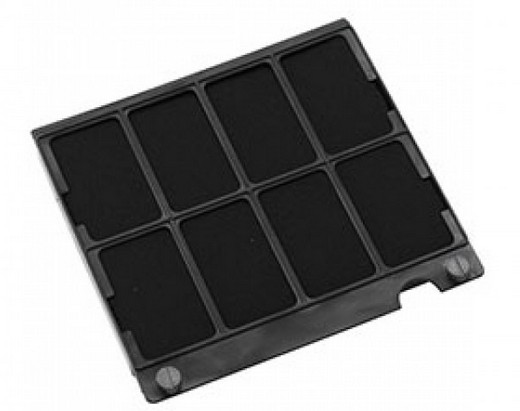
Flat hoods without extraction are designed to purify the air in the room. They have appeared recently. A drainless hood, just like a regular hood, is installed above the stove. The air is not vented to the outside, it becomes clean, thanks to the carbon filter.
Built-in and without outlet
The circulation hood can be part of the kitchen decor, but it can also be hidden, for example, in a wall cabinet. For this, built-in hoods have been developed. The panel in such devices can be either retractable or with a fixed position.
For kitchen
During cooking, fumes appear in the kitchen, which the hood without a drain must capture and hold. The purpose of the kitchen hood is to purify the air in the entire apartment, and not just in the kitchen. a separate ventilation system is used.
Advice: To increase the life of the charcoal filter, the hood should not be turned off immediately after turning off the stove in the kitchen. Leave it on for another 10 minutes. Clean air will dry the filter.
Charcoal filters for hoods from different manufacturers
The production of carbon filters is carried out by companies in different countries. We list the most popular companies and indicate the life of the carbon filters of their production:
- Elica (filter change after 2 months);
- Elikor (3 or 4 months);
- Jetair (3 or 4 months);
- Falmec (4 months);
- Fabriano (six months);
- Krona (half a year - a year);
- Gaggenau (six months);
- Bosch (year).
Folter
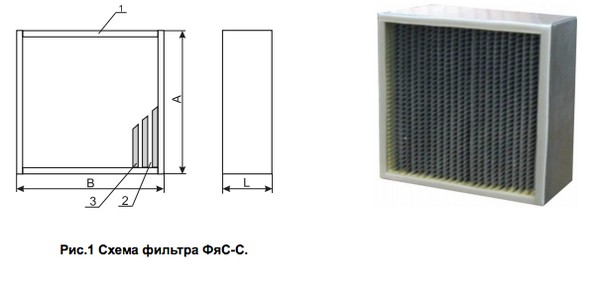
Folter charcoal filters use different types coal and chemisorbents. The air is cleaned of contaminants in the form of gases and vapours. Odors are absorbed. There are filters for different rooms by appointment (canteens, cafes, treatment facilities, etc.) For example, FyaS-S carbon filter.
jet air
Jetair is an Italian manufacturer of ventilation systems. The company was founded in 1984. Now part of the Elica Group, which produces hoods. The cost of Jetair carbon filters is from 370 to 850 rubles.
Elikor
Elikor is a Russian company. The direction of its activity is kitchen hoods and air purifiers. The design of Elikor devices is diverse: from traditional to modern. Elikor F-05 is compatible with the Elikor Integra hood. 400 cubic meters per hour - filter performance.
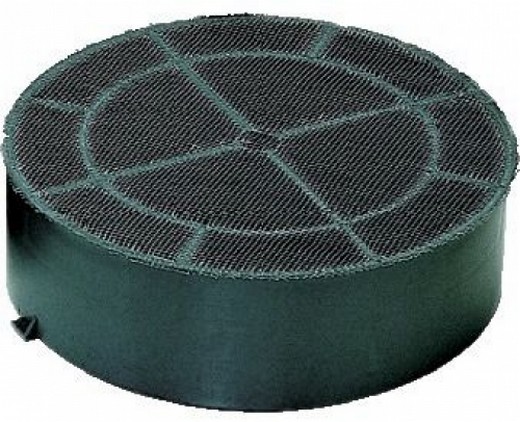
There are universal filters suitable for different recirculation hoods.
Crown
The Krona K5 carbon filter is used in Krona hoods (Bella, Janna Diana, Kamilla). Krona K5 is round in shape. Compatible with Kamilla 600 single motor hood.
Cata
Production - China. For example, Cata TCF-001. Used in Cata, Apelson air, Nodor testa hoods.
Elica
Built into the kitchen hood for air recirculation, neutralizes odors. With frequent use of the hood, the filter should be changed after six months of use. With sparing - after 9 months.
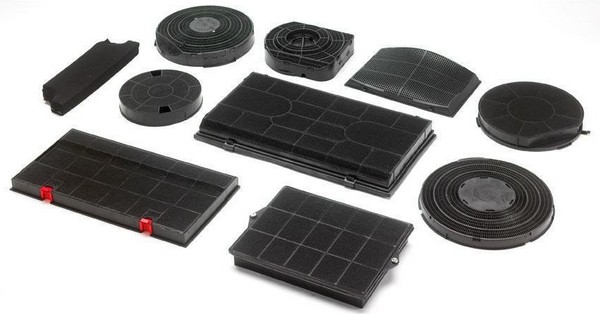
The company manufactures Long Life remanufactured carbon filters. They can be washed, dried and reused. Such devices serve 3 years.
Electrolux Type 150
Filter type - Long life. Eliminates odors by recirculating air. Connection of the hood to the ventilation system is not required. Suitable for Electrolux EFC hoods (639, 939).
WhirlPool
For Whirlpool hoods, Whirlpool, Type 10, Type 28, Type 190, Type 150 filters are suitable.
How to install a carbon filter in the hood
Before installing the filter, the hood must be disconnected from the mains. We remove the grid. If the hood is equipped with two types of filters, remove the grease, take out the cassette with a carbon filter and install a clean carbon filter: a click should sound.
Examine the charcoal filter housing. Perhaps the device can not be changed, but restored by filling in new coal.
The cost of carbon filters for hoods
Prices for carbon filters from different manufacturers range from 250 to 2500 rubles.
Where to buy a carbon filter for the hood?
There are many offers of carbon filters in online stores for different types air purifiers. You can buy a filter at M.Video or at a nearby ventilation systems store.
In Moscow:
Enter, Eldorado, Forema, Stylish Kitchens, Kukhnistroy, Announcement, Our Brand, Sputnik Style.
In St. Petersburg:
Enter, Sooktechno.ru (shop-warehouse), Ren Kitchens, Likarion, Trade-M, New Kitchen.
Video
By purchasing a hood that operates in recirculation mode, you save money, because it costs less than an analogue with the removal of polluted air. This is a modern solution to the problem of purifying indoor air.
Jul 9, 2015 ventsyst



